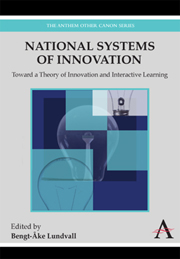Book contents
- Frontmatter
- Contents
- List of Tables
- List of Figures
- Preface
- 1 Introduction
- Part I Toward a New Approach to National Systems of Innovation
- Part II A Closer Look at National Systems of Innovation
- Part III Opening National Systems of Innovation: Specialisation, Multinational Corporations and Integration
- 10 Export Specialisation, Structural Competitiveness and National Systems of Innovation
- 11 The Home Market Hypothesis Re-examined: The Impact of Domestic User-Producer Interaction on Export Specialisation
- 12 Integration, Innovation and Evolution
- 13 National Systems of Innovation, Foreign Direct Investment and the Operations of Multinational Enterprises
- 14 Public Policy in the Learning Society
- 15 Post Script: Innovation System Research – Where It Came From and Where It Might Go
- Notes
- References
11 - The Home Market Hypothesis Re-examined: The Impact of Domestic User-Producer Interaction on Export Specialisation
from Part III - Opening National Systems of Innovation: Specialisation, Multinational Corporations and Integration
Published online by Cambridge University Press: 05 March 2012
- Frontmatter
- Contents
- List of Tables
- List of Figures
- Preface
- 1 Introduction
- Part I Toward a New Approach to National Systems of Innovation
- Part II A Closer Look at National Systems of Innovation
- Part III Opening National Systems of Innovation: Specialisation, Multinational Corporations and Integration
- 10 Export Specialisation, Structural Competitiveness and National Systems of Innovation
- 11 The Home Market Hypothesis Re-examined: The Impact of Domestic User-Producer Interaction on Export Specialisation
- 12 Integration, Innovation and Evolution
- 13 National Systems of Innovation, Foreign Direct Investment and the Operations of Multinational Enterprises
- 14 Public Policy in the Learning Society
- 15 Post Script: Innovation System Research – Where It Came From and Where It Might Go
- Notes
- References
Summary
Introduction
Part I of this book focuses on the relation between the economic structure, userproducer interaction and learning. It is argued (chapter 4) that learning through interaction between actors from different parts of the economy may have important implications for competitiveness and comparative advantage. However, these insights have largely been ignored by ‘mainstream’ economic theory. Traditionally, textbook explanations of specialisation patterns in international trade have focused on differences in supply conditions. Countries, it is argued, tend to specialise in areas of production that make intensive use of factors of production with which the country is relatively well equipped. However, empirical research has shown that the explanatory power of this type of theory is limited. This initiated an active search for alternative approaches from the early 1960's onwards. Many of the new theories which were developed (often labelled ‘neo-technological’ theories) came to focus on differences in technological capabilities across countries and sectors as the main explanatory factor behind the observed differences in patterns of export specialisation. This focus is now widely shared, also among many ‘mainstream’ economists, and is supported by a large amount of empirical research. However, what causes technological capabilities to differ often remains unexplained. Thus, in this sense, existing theories fail to provide a definite answer to the question of ‘why patterns of export specialisation differ’. This chapter discusses to what extent the theoretical perspective of this book, with its emphasis on the relation between the structure of the domestic economy and its learning capability may throw some further light on this question.
- Type
- Chapter
- Information
- National Systems of InnovationToward a Theory of Innovation and Interactive Learning, pp. 219 - 232Publisher: Anthem PressPrint publication year: 2010
- 3
- Cited by



